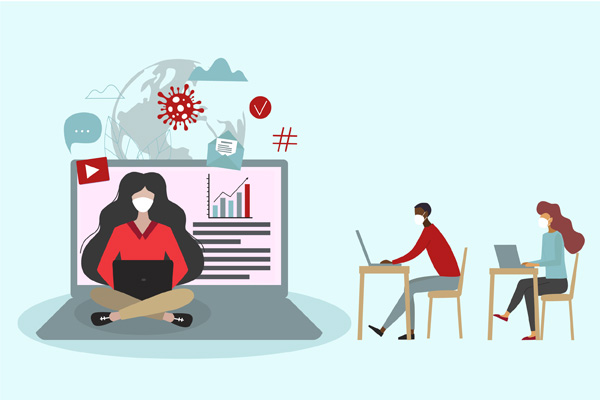Learning From COVID-19: Addressing impacts in Dyson’s curriculum

The impact COVID-19 has had on business around the world is massive. Faculty teaching the business leaders of tomorrow have had to pivot their course curriculum to keep pace with changing practices as organizations scramble to meet new realities and meet demand.
Charles H. Dyson School of Applied Economics and Management faculty addressed many facets of the unique and unprecedented challenges posed by the COVID-19 pandemic in their curriculum beginning in the spring 2020 semester, when the lockdowns began, and continuing on through this spring. This allowed students to keep pace with a world in flux, and understand new and evolving ways of doing business.
Impacting consumer behavior in the food industry

In the course AEM 5480 From Labels to Lab-Grown Meat: Consumer Behavior and the Food Industry, David Just, Susan Eckert Lynch Professor in Science and Business, and his students examine food consumer behavior and food industry responses. To detail COVID’s impact in this sphere, Just planned an entire week on how consumers have responded to COVID.
“This includes industry data on the rise in popularity of home delivery and pick up among grocery stores, consumer stated intentions to return to in person shopping when they have the ability, etc.,” he says. “I also cover some of the psychology of fear—when the store shelves were empty, the food pantry lines stretched for miles, many were struck with panic.”
From this panic and fear, Just wanted to make it clear to students that consumer behavior with food services was actually relatively predictable.
“We saw substantial rises in sales of comfort foods,” he said. “There was also a dramatic rise in sales of frozen foods as people suddenly became super sensitive to shelf life and the ability to store their food. They began insuring themselves against future stock-outs.”
According to Just, this also led to shifts in consumer trust of industry, science, government, and food influencers. Some of the materials conveyed in classes included prior work on fear and food behavior, but much of it drawn from industry and academic research publications from the last year.
“I think the biggest lesson is that the essentials, like food, become a big focus when we feel that we are under existential threat,” he said. “This is a feeling that drove rapid innovation and adjustment by both industry and consumers. It is unclear how sustained these changes will be, but the changes were profound and rapid.”
For students, a primary takeaway is the strength of the food system during times of uncertainly and change.
“While the bumps along the way demonstrated some weaknesses and instability in our food system, most of these can be addressed,” Just said. “In other words, our food system actually performed robustly in the face of a crisis unlike anything seen in century.”
Implications for work, workers, and organizations

In AEM 3245 / 6245 Organizational Behavior, Kevin Kniffin, assistant professor of management and organizations, says that there are both near- and longer-term impacts of the pandemic and related lockdowns that academics and students will need to be attentive to understanding and mitigating.
And, like the proverbial iceberg, says Kniffin, many of those changes are not necessarily visible yet.
“The impacts of the pandemic and related lockdowns are highly varied across different groups. In fact, while some commentators have talked about the “k-shaped” recovery, I’ve been quick to highlight that there isn’t a letter in the English alphabet that captures the MANY varied dimensions on which there appear—already—to be divergent outcomes related to the pandemic.”
Kniffin says researchers are already developing multi-year proposals to unpack what happened and how workers, work, and organizations can be most responsive.
“If you consider, for example, that researchers found it important before the pandemic to understand the impact of how many days a given school district was closed in relation to student outcomes, then it becomes easier to appreciate the long-time horizon on which we should be aware of persistent impacts of the COVID-19 and related lockdowns,” he says.
“Just as importantly, this long-time horizon should encourage careful thinking to support solutions to mitigate losses that have already been incurred and ideally prevent damage that might otherwise emerge from future crises.”
Supply chain upheaval

Associate Professor of Applied Economics and Policy Bradley Rickard’s course AEM 2310: Business and Economics of Food is divided into three sections; food production, food distribution, and food consumption. In each segment the class spent time discussing and analyzing the effects of COVID on these different segments of the food supply chain.
“For example, in the food distribution section we have discussed how COVID has impacted the supply chain for meat products—and potentially fresh produce—and use this as a nice example of how a disruption in the middle part of the channel can lead to lower prices for farm products and, at the same time, higher prices for the retail products facing consumers.”
A valuable lesson for students, Rickard says that this is an excellent example to showcase that prices do not always move in the same direction along the supply chain.
“In the last part of the course we discuss food waste and will again use the case of COVID to discuss and analyze how the shock/disruption from COVID affected the ratio of food purchased at food service versus food retail markets, and coupled with the “normal” rates of food waste, how this impacted the net amount of food waste in 2020.”
But the big takeaway for students, according to Rickard, is how the disruption impacted horizontal food supply chains—food retail vs food service—and vertical food supply chains—farm to fork—at the same time.
“The ‘food system’ is made up of many moving parts, and the COVID experience has showcased how connected these markets are and how sensitive/fragile the linkages can be in food and beverage markets—especially those that involve perishable products.”
Investments in rapid technology adaptation

In Senior Lecturer Daniel Hooker’s course AM2480 The Dynamics of the Food Industry and Consumer Packaged Goods, he showcased the dynamics of the whole food industry turning into hyperdrive—seeing changes that were already slowly taking place, happen in months.
“A good example of this is online shopping,” he says. “Pre-COVID, everyone was starting to do shopping online, and online orders were growing fairly rapidly, but it wasn’t necessarily growing as rapidly in the grocery food space. Then, the pandemic happens and consumers don’t want to go into stores and, all of a sudden, a shopper is now buying lots of stuff online and that can be delivered to the home or through ‘click and collect’ where they pick up.”
According to Hooker, chains have rapidly transitioned from ‘we’re thinking about developing it’ to ‘we need it.’ Technology investments for all of these new capabilities have happened quickly and are predicted to continue to evolve and improve. Focusing his classes on the practical vs the theoretical, discussing what’s happening today and how to apply the concepts, Hookers teaching has had to pivot to showcase this new reality.
“One year ago, we were talking about the new entrance of brands in health and wellness, and sustainability but they were commanding a lot of self-space whether in a store or virtually,” he says. “All of a sudden, the pandemic happens and it’s a shift to ‘we need to keep the basics on the shelves and stay in stock.’ So, these companies had to pivot due to a surge in demand and I needed to update all of my ‘what’s happening in the world around the consumer’ to ‘adjusting to life around the pandemic.’”
An example of this would be consumers no longer able to sample items in store, and companies no longer able to promote specific products through merchandizing with big displays.
“Last fall, I was teaching Supply Change Strategy and we have a supermarket simulation project as part of the program,” Hooker said. “The general topics were the same, but right now it’s about ‘what are you doing about COVID, what have you changed, and what are you doing differently.”
A priority for Hooker, “we’ve needed to focus on what’s changes, what’s staying the same, what will go back post-pandemic and what changes are here into the future.”
It has been a delicate balance around incorporating new thinking and new examples to teach concepts, such as supply chain management and distribution, he says.
“The challenge is to apply what’s happening in the world to the concepts taught in the course and connecting the dots for students. This led to excellent conversations with students, rich discussions.”
